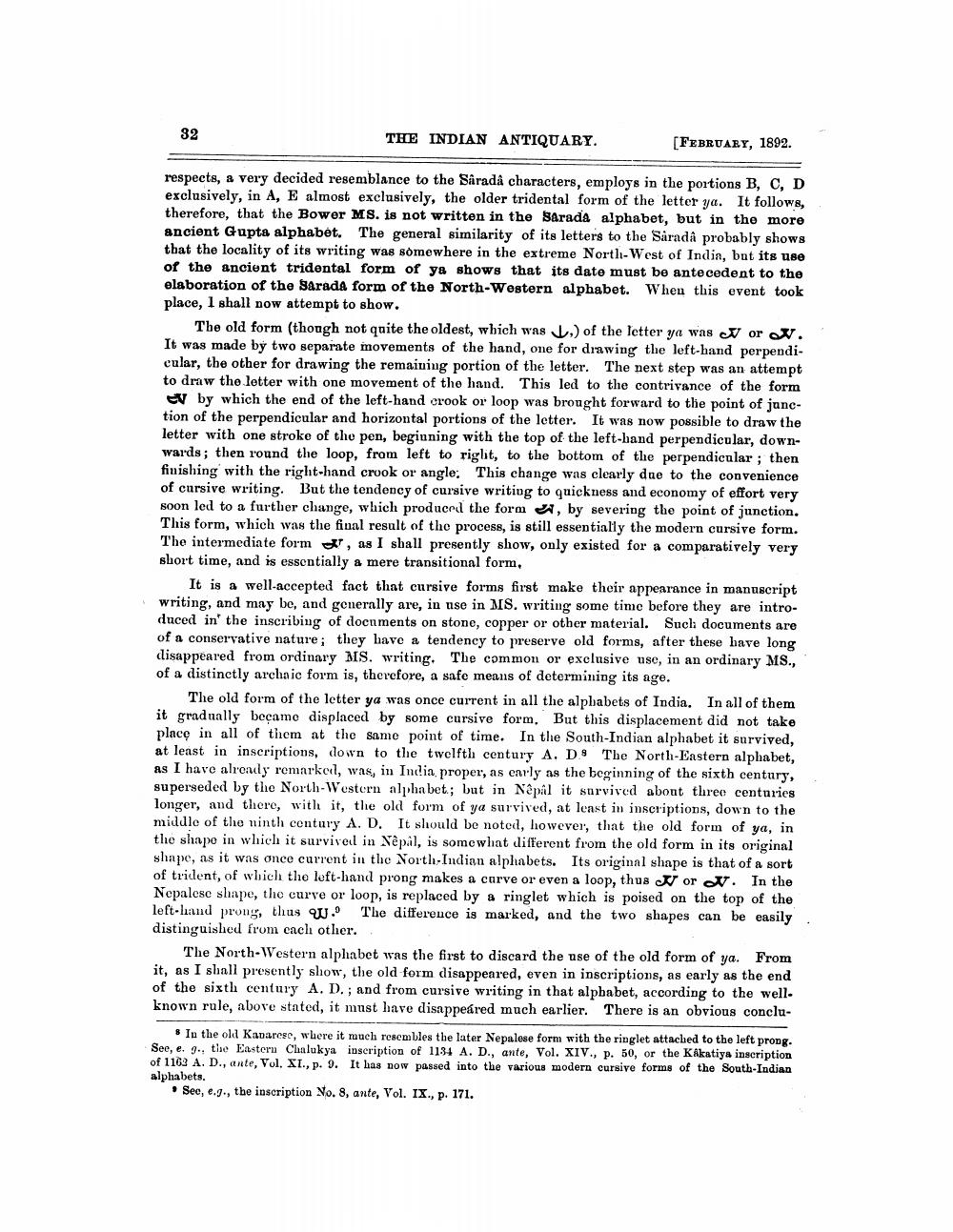________________
32
THE INDIAN ANTIQUARY.
(FEBRUARY, 1892.
respects, a very decided resemblance to the Sâradâ characters, employs in the portions B, C, D exclusively, in A, E almost exclusively, the older tridental form of the letter ya. It follows, therefore, that the Bower MS. is not written in the Sarada alphabet, but in the more ancient Gupta alphabet. The general similarity of its letters to the Sarada probably shows that the locality of its writing was somewhere in the extreme North-West of India, but its use of the ancient tridental form of ye shows that its date must be antecedent to the elaboration of the Sarada form of the North-Western alphabet. When this event took place, I shall now attempt to show.
The old form (though not quite the oldest, which was 1) of the letter ya was Vor V. It was made by two separate movements of the hand, one for drawing the left-hand perpendicular, the other for drawing the remaining portion of the letter. The next step was an attempt to draw the letter with one movement of the hand. This led to the contrivance of the form
V by which the end of the left-hand crook or loop was brought forward to the point of janetion of the perpendicular and horizontal portions of the letter. It was now possible to draw the letter with one stroke of tho pen, beginning with the top of the left-hand perpendicular, downwards; then round the loop, from left to riglit, to the bottom of the perpendicular; then finishing with the right-hand crook or angle. This change was clearly dae to the convenience of cursive writing. But the tendency of cursive writing to quickness and economy of effort very soon led to a further change, which produced the form by severing the point of junction. This form, which was the final result of the process, is still essentially the modern cursive form. The intermediate form of, as I shall presently show, only existed for a comparatively very short time, and is essentially a mere transitional form,
It is a well-accepted fact that cursive forms first make their appearance in manuscript writing, and may be, and generally are, in use in MS, writing some time before they are introduced in the inscribing of documents on stone, copper or other material. Such documents are of a conservative nature; they have a tendency to preserve old forms, after these have long disappeared from ordinary MS. writing. The common or exclusive use, in an ordinary MS., of a distinctly archaic form is, therefore, a safe means of determining its age.
The old form of the letter ya was once current in all the alphabets of India. In all of them it gradually became displaced by some cursive form. But this displacement did not take place in all of them at the same point of time. In the South Indian alphabet it survived, at least in inscriptions, down to the twelfth century A. D9 The North-Eastern alphabet, As I have alreadly remarkel, was, in India, proper, as early as the beginning of the sixth century, superseded by the North-Western alphabet; but in Nepal it survived about three centuries longer, and there, with it, the old form of ya survived, at least in inscriptions, down to the middle of the ninth century A. D. It should be noted, however, that the old form of ya, in the shape in which it survived in Nepal, is somewhat different from the old form in its original shape, as it was once current in the North Indian alphabets. Its original shape is that of a sort of trident, of which the left-hand prong makes a carve or even a loop, thus N or N. In the Nepalese shape, the curve or loop, is replaced by & ringlet which is poised on the top of the left-hand prong, thus W. The difference is marked, and the two shapes can be easily distinguished from cach other.
The North-Western alphabet was the first to discard the use of the old form of ya. From it, as I shall presently show, the old form disappeared, even in inscriptions, as early as the end of the sixth century A. D.; and from cursive writing in that alphabet, according to the well. known rule, above stated, it must have disappeared much earlier. There is an obvious conclu
$ In the old Kavarese, where it much resembles the later Nepalese form with the ringlet attached to the left prong. See, e. 9.. the Easteru Chalukya inscription of 1134 A. D., ante, Vol. XIV., p. 50, or the Kakatiya inscription of 1162 A. D., ante, Vol. XI., p. 9. It has now passed into the various modern cursive forms of the South-Indian alphabets.
• See, e.g., the inscription No. 8, ante, Vol. IX., p. 171.




